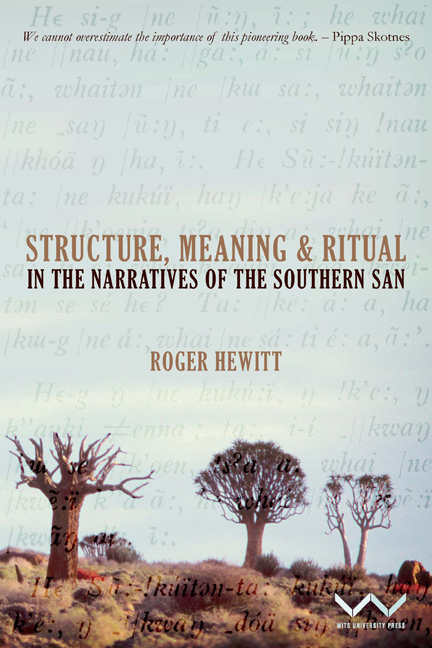Book contents
- Frontmatter
- Dedication
- Contents
- Acknowledgements
- Introduction
- 1 Ethnographic background
- 2 Introduction to the narratives: their context, performance and scope
- 3 Legends and the stories of !Khwa
- 4 Sidereal narratives: the story of the Dawn's Heart and his wife the Lynx
- 5 Animal narratives
- 6 |Kaggen in belief and ritual
- 7 The |Kaggen narratives (1): characters and content
- 8 The |Kaggen narratives (2): sequence and structure
- 9 |Kaggen in belief, ritual and narrative: a synthesis
- 10 Two |Kaggen narratives: compositional variations
- 11 The verbal surface: a note on the narrators
- Appendix A Girls’ puberty observances of the ǀXam
- Appendix B The shamans of the ǀXam
- Bibliography
- Index
7 - The |Kaggen narratives (1): characters and content
Published online by Cambridge University Press: 21 April 2018
- Frontmatter
- Dedication
- Contents
- Acknowledgements
- Introduction
- 1 Ethnographic background
- 2 Introduction to the narratives: their context, performance and scope
- 3 Legends and the stories of !Khwa
- 4 Sidereal narratives: the story of the Dawn's Heart and his wife the Lynx
- 5 Animal narratives
- 6 |Kaggen in belief and ritual
- 7 The |Kaggen narratives (1): characters and content
- 8 The |Kaggen narratives (2): sequence and structure
- 9 |Kaggen in belief, ritual and narrative: a synthesis
- 10 Two |Kaggen narratives: compositional variations
- 11 The verbal surface: a note on the narrators
- Appendix A Girls’ puberty observances of the ǀXam
- Appendix B The shamans of the ǀXam
- Bibliography
- Index
Summary
Of the 21 narratives relating to ǀKaggen collected by Bleek and Lloyd, 15 emphasise ǀKaggen's quarrelsome, greedy and anti-social nature, while the remaining six portray him as primarily benevolent and helpful. His character in this latter group of narratives most closely resembles the ǀKaggen of von Wielligh's collection – that of the benevolent overseer intervening helpfully in the affairs of others. While there are several points of overlap between these two groups, so radical is the difference between the character of ǀKaggen in each group, and so different is his role within the narratives, that it is necessary to treat them separately.
Paul Radin discovered a similar dichotomy in the trickster cycle of the Winnebago Indians but regarded it as the intrusion of one distinct group of culture-hero narratives upon another purely trickster-centred cycle (Radin 1956: 155ff). However, given ǀKaggen's dual religious nature there are more grounds for assuming that the ǀXam narratives reveal a genuine ambiguity concerning ǀKaggen's character than that they represent a welding together of disparate groups.
What shall be termed ‘Group A’ contains the following narratives:
M1. ǀKaggen and the Eland (five versions)
M2. ǀKaggen and !Goe !kweitɘntu (three versions)
M3. A Visit to the Lions (two versions)
M4. ǀKaggen and the Cat (two versions)
M5. ǀKaggen and the Aard-wolf (two versions)
M6. !Gãunu ts'axau and the Baboons (one version)
M7. ǀKaggen and the Magic Bird (two versions)
M8. ǀKaggen Takes Away the Ticks’ Sheep (three versions)
M9. ǀKaggen and ǁKwai-hɛm (two versions)
M10. ǀKaggen and the Elephants (two versions)
M11. ǀKaggen, ǀKwammang-a and the Dassies (three versions)
M12. ǀKaggen and the Koro-twi:tɘn (one version)
M13. ǀKaggen and ǀKu-te-!gaua (one version)
M14. ǀKaggen Assumes the Form of a Hartebeest (one version)
M15. ǀKaggen and the Leopard Tortoise (one version)
Group B contains:
M16. ǀKaggen, the ǀKain-ǀkai:n and the Girls (one version)
M17. The Wildebeest, the Mice and the Quaggas (one version)
M18. The Lizard, his Daughter and the Mice (one version)
M19. The Mice and the Beetle (one version)
M20. The Blue Crane's Story (one version)
M21. The Children and the !Khwai-!khwai (one version)
The validity of this division will become more apparent as the discussion proceeds but, apart from the difference in ǀKaggen's character in each group, certain other differences may also be mentioned at this stage. All group A narratives situate ǀKaggen within the same family unit.
- Type
- Chapter
- Information
- Publisher: Wits University PressPrint publication year: 2008



